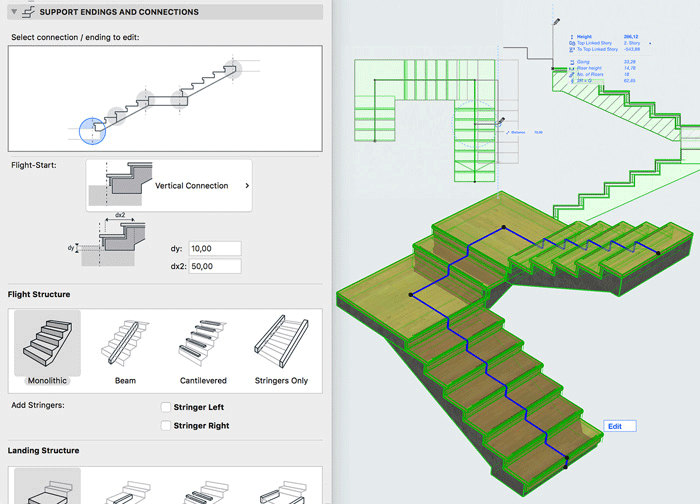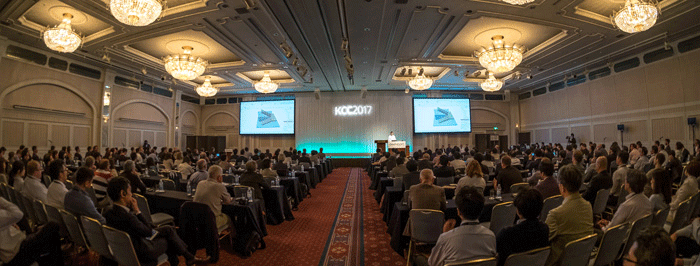Graphisoft held a key customer conference in Kobe, Japan, to launch ArchiCAD 21 and to highlight increasing BIM usage in the Pacific Rim. Martyn Day attended to hear the latest on the software, processes, collaboration and to drink a little sake.
Three years ago, Graphisoft held a similar conference in Tokyo, Japan, which highlighted the company’s decision to focus on Asia as a place for BIM growth. That decision was a calculated one as these markets are culturally distinct from the west and have their own processes and workflows. While Autodesk was dominating with Revit in other geographies, Asia was a tougher market to break as off-the-shelf BIM modelling tools are less fit for purpose. Graphisoft was willing to work with large firms to incorporate their requirements and react to requests for solutions.
At the time this was seen as a risky strategy, as the BIM market was hot in the West but sluggish in Asia and there was a danger that a focus on one market could pervert development of the core product for existing users. Three years on, it’s clear that this was a gamble worth taking and the additional input has not impacted development of ArchiCAD – only contributed to help drive the application to deliver even more value for modellers and especially in the quality of the 2D output.
At the time, Graphisoft’s CEO, Viktor Várkonyi, explained that another danger was to overcommit to providing capability and to under deliver. Especially in Japan, this was culturally unacceptable. Firms which have done this in the past have found themselves shut out of the market as reputations matter.
Software firms are typically not the best at delivering on their promises, as they are pulled in many directions by global customers. I’m glad to see that, three years on, Graphisoft’s reputation is intact and ArchiCAD usage is starting to spread across the region, with customers from China, Singapore and Australia presenting at the Kobe event.
Viktor Várkonyi
Várkonyi sees ArchiCAD as essentially a design tool and recognises the gap between BIM and construction models, identifying that more work needs to be done by all vendors to better connect both parts of the process. This will be done also through other Nemetschek products such as Solibri and Bluebeam.
ArchiCAD is intended to be the master model, defining everything to LOD300, with associated 2D drawings and non-graphic construction data. We can expect much tighter / seamless integration with products which Nemetschek has acquired to serve the design and building industries. Graphisoft’s Asian clients appear to be driving this development.
On the business front, Graphisoft appears to be to doing well, with customers spread throughout Europe, Asia, and North America. In Asia, usage has gone from 17% to 42% in a year, with 55% of revenue coming from new customers. By my estimates, Graphisoft has doubled in 3 years. The company is benefitting from the increase in the appetite for BIM.
One of ArchiCAD’s biggest strengths over Revit is its ability to handle large models without becoming unwieldy. In many demonstrations throughout the conference this was clearly shown, in one instance an ArchiCAD customer loaded a 14GB hospital model into the BIMcloud with 40 people accessing it simultaneously. On that note, Graphisoft has stated it will create an API for BIMcloud, allowing other firms to access the BIM model.
Mobile devices are much more memory- limited than desktop machines, which restricts Graphisoft’s BIM model sharing application BIMx. To get around this, the next version of BIMx will enable streaming, so there will be no limit to the models which can be shown on phones and tablets when there is a data connection.
The link with McNeel Rhino Grasshopper is going from strength to strength. With each successive release of ArchiCAD, Graphisoft is refining and deepening the ability to computationally control ArchiCAD’s BIM elements.
The alliance between McNeel and Graphisoft will see Rhino/Grasshopper with ArchiCAD operating as a pre-design combination, allying the easy script generation of Grasshopper with the powerful modelling of ArchiCAD components. 50% of existing ArchiCAD large customers use Rhino and Grasshopper in their design mix. This integration is also winning new fans in competitors’ installed bases and will lead to ArchiCAD being used by a whole new set of users.
Várkonyi also told the press that this link to Rhino will not only be at the start of the design process but will also remain connected for downstream changes. For now, it can work with walls, parametric elements and stories. In the future the API integration will get extremely deep between these two products, with Grasshopper being able to access GDL objects and design optimisation loops.
However, Várkonyi sees the next big challenge of the BIM market to be really all about workflow, concluding: “Those who have the best workflow win”. BIMcloud adoption has been slow but it’s a step change in the way clients connect their offices and teams and has required firms to rethink their set-up. Using BIMcloud Manager with BIMcloud Servers enables a flexible mix of deployments but has required Graphisoft to work towards improved integration with its own suite of add-on applications to make is more seamless.
ArchiCAD 21
The latest release of ArchiCAD is a bit more eclectic than previous themed releases but I’m not going to hold that against Graphisoft. The main and outstanding feature is the complete reworking of the stair creation tool. I’ve never seen such a powerful BIM component generation tool and it’s very easy to use. Prior to going to Japan, I sat in on an hour session in London that just covered what the stair tool can do! If you want to design something funky, complex, curvy, highly customised with a hand rail, this is your program. The software will even check how ergonomic it is, to get the optimal design.

Graphisoft always picks a customer’s project to appear on the box and this year’s is the Charles Perkins Centre, Sydney, Australia by Francis-Jones Morehen Thorp studio (fjmtstudio.com). The amazing organic staircase says it all really.
Graphisoft made a lot of noise about this being the first real application of Artificial Intelligence in a BIM application, using a predictive algorithm to assist in the designing of complex and standard stair casing. As the designer creates the staircase the system also warns if any design may infringe on local standards. The system can suggest alternatives and out of thousands of possible options, suggests four that will work.
IFC files can now be placed as hotlinks into projects as reference content. IFC reference content can be filtered by categories, such as Structural or MEP, or by element selection. IFC model content can be updated from the linked source file and if the link is broken, elements within the IFC can be edited as regular ArchiCAD elements.
In the past, ArchiCAD only allowed a fixed set of Element Classifications. In version 21, it’s not possible to classify elements to match any national or company-standard classification system. Classifications can be transferred between projects via XML file format.
The CineRender engine by MAXON (also owned by Nemetschek) has been updated. The latest version introduces Light Mapping and Secondary GI methods for more realistic, yet fast rendering. Expect Lens distortion, reflectance enhancements and more shading modes.
Collision Detection is now a standard part of the feature set. There have also been enhancements to doors, windows, labels, curtain walls, IFC publishing and sections and elevations.
We will have a full review of ArchiCAD 21 in the next edition of AEC Magazine.
Customer presentations
Over the two days of the conference, the stage was dominated by a wide range of customer presentations from the likes of: LWK & Partners, HDR | Rice Daubney, Surbana Jurong, FJMT, Kajima Corp, GS E&C and John Robertson Architects.
The striking similarity was the toolsets that these firms were deploying in addition to ArchiCAD: Solibri, Rhino / Grasshopper, Bluebeam and even dRofus (planning and data management application owned by Nemetschek).
During my previous trip to Tokyo, three years ago, I noted that each firm had a distinctly different approach to their internal BIM design process and also used various product mixes. Three years later and the toolsets are standardising and products like Solibri (also recently acquired by Nemetschek) seem to have become the de facto standard model checking software both for internal and external checking of complex BIM data. As these firms which operate in the Pacific Rim work together more connecting up their tool sets and processes at quite an impressive pace.
Looking back to Europe and the Americas, while the UK is the most advanced in demanding BIM deliverables and processes, this has taken a long time and is still far from perfect. While the West spends a lot of time codifying and developing standards, China, Japan and Singapore are making considerable strides to move to BIM with less general reticence.
Conclusion
Sometimes small decisions in software product design can make huge differences to their appeal to customers. From what I can see, Graphisoft has made two decisions which have ignited growth of sales and which also appeal to those who had perhaps been understood to have already made their BIM tool choice. A focus on Asia and a decision to not develop but to partner and integrate McNeel’s Grasshopper have proven to be pivotal.
With Bentley having GC (Generative Components), Autodesk developing Dynamo, Graphisoft could have thrown valuable resources at creating its own programmatic design language and integrated it deep into ArchiCAD. But it would only have appealed to existing customers and would have required years of work to get anywhere near the complexity of the competition.
Computational Design is still only used by a small proportion of designers and this would have been a major investment. By teaming up with McNeel, Graphisoft taps into an army of young architects and designers, immediately sparks interest in leading Architectural firms and makes the job one of software integration through APIs, as opposed to reinventing the wheel.
Rhino and Grasshopper are big in Japan, but they are also big in London, New York, San Francisco, Chicago, Paris, Barcelona and the Nordics. From release to release the level of integration is delivering on Graphisoft’s promise and this is getting the company in through the doors of mature Revit customers that want to use Grasshopper with BIM components and love the idea they can spin huge models within 16GB of RAM.
Large American corporates selling volume product are a lot less likely to tailor products in markets which will not guarantee high volume return. Graphisoft’s size and approach to customers means that delivering more tailored solutions and functionality is less of an arduous task. Understanding that Japanese clients are demanding and that they expect to get what’s been agreed is a serious commitment.
From the numbers Graphisoft is quoting, it’s surfing on a wave of BIM adoption and is benefiting from the respect the firm and its employees pay to their Japanese customers. It’s amazing to meet so many Hungarians that can speak Japanese! At one of the events even the Hungarian ambassador appeared and gave an English and Japanese address, with an obvious sense of pride that here was an small Hungarian software firm that doing so well in such a complex market.
ArchiCAD 21 is yet again another significant addition to the product feature set and I say in all honesty, it’s worth buying a copy just to create funky stairs in any mature BIM process, there’s nothing on the market quite like it.

If you enjoyed this article, subscribe to AEC Magazine for FREE






